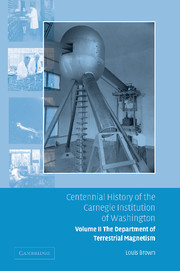Book contents
- Frontmatter
- Contents
- Foreword by Richard A. Meserve
- Preface
- 1 Establishment
- 2 Cruises and war
- 3 Expeditions
- 4 Measurements: magnetic and electric
- 5 The Fleming transition
- 6 The last cruise
- 7 The magnetic observatories and final land observations
- 8 The ionosphere
- 9 Collaboration and evaluation
- 10 The Tesla coil
- 11 The Van de Graaff accelerator
- 12 The nuclear force
- 13 Fission
- 14 Cosmic rays
- 15 The proximity fuze and the war effort
- 16 The Tuve transition
- 17 Postwar nuclear physics
- 18 The cyclotron
- 19 Biophysics
- 20 Explosion seismology
- 21 Isotope geology
- 22 Radio astronomy
- 23 Image tubes
- 24 Computers
- 25 Earthquake seismology
- 26 Strainmeters
- 27 The Bolton and Wetherill years
- 28 Astronomy
- 29 The solar system
- 30 Geochemistry
- 31 Island-arc volcanoes
- 32 Seismology revisited
- 33 Geochemistry and cosmochemistry
- 34 The Solomon transition
- 35 The support staff
- 36 Epilogue
- Notes
- Index
16 - The Tuve transition
Published online by Cambridge University Press: 06 January 2010
- Frontmatter
- Contents
- Foreword by Richard A. Meserve
- Preface
- 1 Establishment
- 2 Cruises and war
- 3 Expeditions
- 4 Measurements: magnetic and electric
- 5 The Fleming transition
- 6 The last cruise
- 7 The magnetic observatories and final land observations
- 8 The ionosphere
- 9 Collaboration and evaluation
- 10 The Tesla coil
- 11 The Van de Graaff accelerator
- 12 The nuclear force
- 13 Fission
- 14 Cosmic rays
- 15 The proximity fuze and the war effort
- 16 The Tuve transition
- 17 Postwar nuclear physics
- 18 The cyclotron
- 19 Biophysics
- 20 Explosion seismology
- 21 Isotope geology
- 22 Radio astronomy
- 23 Image tubes
- 24 Computers
- 25 Earthquake seismology
- 26 Strainmeters
- 27 The Bolton and Wetherill years
- 28 Astronomy
- 29 The solar system
- 30 Geochemistry
- 31 Island-arc volcanoes
- 32 Seismology revisited
- 33 Geochemistry and cosmochemistry
- 34 The Solomon transition
- 35 The support staff
- 36 Epilogue
- Notes
- Index
Summary
There were indications in 1946 that postwar science would differ significantly from what had gone before. Wartime research had had unlimited financial support and had presented the country with astounding new weapons and useful applications. If such generous support yielded valuable weapons, similar support would surely produce remarkable progress in pure science, many branches of which were becoming increasingly dependent on ever costlier instruments. These thoughts were rampant among the scientists returning to their university campuses, and it was from the Federal government that they expected to obtain this new funding, expectations that were indeed fulfilled. Furthermore, in a social experiment never tried before, Congress passed the GI Bill of Rights that, among other benefits, gave war veterans the chance to obtain a university education, and a large, enthusiastic crop of new scientists resulted. The Institution was not yet aware of what all this meant for their mode of research, but as the decades slipped by and a radically new way of doing science emerged, it would find the ability to adapt.
John Fleming retired as Director of the Department after having presided over fundamental changes in its scientific course; it would have been scarcely recognizable to his predecessor. He was followed in that office in 1946 by Merle Tuve, who planned to make even greater changes. In this he was in accord with Vannevar Bush with whom he had worked closely for five years.
- Type
- Chapter
- Information
- Centennial History of the Carnegie Institution of Washington , pp. 117 - 124Publisher: Cambridge University PressPrint publication year: 2005



